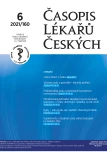-
Medical journals
- Career
Fish – a source of dietary exposure to iodine and other chemicals
Authors: Irena Řehůřková; Jan Šmoldas; Marcela Dofková; Jiří Ruprich
Authors‘ workplace: Centrum zdraví, výživy a potravin, Státní zdravotní ústav, Brno
Published in: Čas. Lék. čes. 2021; 160: 242-248
Category: Review Article
Overview
Fish, fish products and seafood are an important part of a healthy diet. They make an important contribution as a dietary source of iodine, but also of other substances that have a positive effect on the human body. On the other hand, they contain contaminants (especially mercury/methylmercury) whose toxic properties affect food safety. Based on the results of dietary exposure monitoring and specialised studies by the National Institute of Health – Centre for Health, Nutrition and Food and international activities it can be concluded that there are clear benefits in terms of human health from the consumption of fishery products. Women and children should take care to include these products in their diets. The mercury/methylmercury content of common products in the Czech Republic is under control and the concentration levels are practically below the legislative limits. Care should be taken with fish and fish products where mercury may accumulate. The response of the European Commission, which is currently calling for a review of the maximum permissible limits for mercury/methylmercury in various fish species, is appropriate. This could help to further reduce dietary exposure to mercury in food and encourage fish consumption.
Keywords:
Fish – Nutrients – Contaminants – Iodine – fish products – mercury – methylmercury
Sources
- Evropská komise. Nařízení č. 1881/2006 ze dne 19. 12. 2006, kterým se stanoví maximální limity některých kontaminujících látek v potravinách. Dostupné na: https://eur-lex.europa.eu/legal-content/CS/TXT/PDF/?uri=CELEX:32006R1881&from=CS
- Brázdová Z. Výživová doporučení pro Českou republiku. Rega, Brno, 1995.
- Brázdová Z, Ruprich J, Hrubá D, Petráková A. Dietary guidelines in the Czech Republic III: Challenge for the 3rd millenium. Cent Eur J Public Health 2001; 9 : 30–34.
- Ruprich J, Dofková M, Řehůřková I a kol. Individuální spotřeba potravin – národní studie SISP04. CZVP SZÚ, 23. 6. 2018. Dostupné na: http://czvp.szu.cz/spotrebapotravin.htm
- Ruprich J. a kol. Systém monitorování zdravotního stavu obyvatelstva ČR ve vztahu k životnímu prostředí – subsystém IV, Zdravotní důsledky zátěže lidského organizmu cizorodými látkami z potravinových řetězců, Dietární expozice. Odborná zpráva za rok 2020. SZÚ, 2021. Dostupné na: www.szu.cz/uploads/CZVP/Dietarni_monitoring_2020.pdf
- EFSA NDA Panel. Scientific opinion on dietary reference values for iodine. EFSA Journal 2014; 12 : 3660.
- EFSA. Dietary reference value for EU, DRV finder. EFSA, 2019. Dostupné na: https://efsa.gitlab.io/multimedia/drvs/index.htm
- National Institutes of Health. Nutrient Recommendations: Dietary Reference Intakes (DRI). NIH, 2021. Dostupné na: https://ods.od.nih.gov/Health_Information/Dietary_Reference_Intakes.aspx
- WHO. Evaluation of certain food additives and contaminants. TRS 922. WHO, Ženeva, 2004. Dostupné na: http://apps.who.int/iris/bitstream/handle/10665/42849/WHO_TRS_922.pdf?sequence=1
- US EPA. IRIS Advanced Search. EPA, 2021. Dostupné na: https://cfpub.epa.gov/ncea/iris/search/index.cfm
- EFSA CONTAM Panel. Scientific Opinion on the risk for public health related to the presence of mercury and methylmercury in food. EFSA Journal 2012; 10 : 2985.
- EUMOFA – European Market Observatory for Fisheries and Aquaculture Products. The EU Fish Market. EUMOFA, 2019. Dostupné na: www.eumofa.eu/documents/20178/314856/EN_The+EU+fish+market_2019.pdf
- Ruprich J. Vitamin D – potraviny, výživa a zdraví. CZVP SZÚ, 2021. Dostupné na: http://szu.cz/tema/bezpecnost-potravin/vitamin-d-v-potravinach
- Ruprich J, Bischofová S, Pernicová H a kol. Omega-3 mastné kyseliny v lidské krvi – omega-3 index. Prevence chronických zánětů. Acta Hygienica Epidemiologica et Microbiologica 2021; 2 : 1–111.
- Ruprich, J, Řehůřková I, Řeháková J a kol. Nebojte se rtuti v rybích výrobcích na trhu v ČR. CZVP SZÚ, 2020. Dostupné na: www.szu.cz/uploads/CZVP/Nebojte_se_rtuti_v3.pdf
- EFSA NDA Panel. Scientific Opinion on health benefits of seafood (fish and shellfish) consumption in relation to health risks associated with exposure to methylmercury. EFSA Journal 2014; 12 : 3761.
- US FDA. Dietary Guidelines for Americans. Questions & answers from the FDA/EPA advice about eating fish for women who are or might become pregnant, breastfeeding mothers, and young children. FDA, 2021 Oct 28. Dostupné na: www.fda.gov/food/consumers/questions-answers-fdaepa-advice-about-eating-fish-women-who-are-or-might-become-pregnant#V
- The Spanish Agency for Food Safety and Nutrition (AESAN). Consumption Advice – Regarding Mercury in fish. AESAN, 2019. Dostupné na: www.aesan.gob.es/AECOSAN/docs/documentos/seguridad_alimentaria/gestion_riesgos/CONSUMPTION_ADVICE_FISH_MERCURY_SPAIN_AESAN.PDF
- Ruprich J, Řehůřková I. Informace vědeckého výboru pro potraviny ve věci: Jod, část I: obvyklý dietární přívod pro populaci. SZÚ, 2007. Dostupné na: http://czvp.szu.cz/vedvybor/dokumenty/informace/Info_2006_18_deklas_JOD%20cast1.pdf
- Ruprich J. Co byste měli vědět o rtuti v rybách a rybích výrobcích. SZÚ, Praha, 2006. Dostupné na: www.szu.cz/uploads/documents/czzp/edice/plne_znani/rtut_20v_20rybach.pdf
Labels
Addictology Allergology and clinical immunology Angiology Audiology Clinical biochemistry Dermatology & STDs Paediatric gastroenterology Paediatric surgery Paediatric cardiology Paediatric neurology Paediatric ENT Paediatric psychiatry Paediatric rheumatology Diabetology Pharmacy Vascular surgery Pain management Dental Hygienist
Article was published inJournal of Czech Physicians

2021 Issue 6-
All articles in this issue
- ÚVODEM
- Iodine and health in the Czech Republic
- Quarter of a century of work of the Intersectoral Commission on Iodine Deficiency Solution
- Iodine status in premature newborns
- Iodine intake monitoring in neonatal population in the Czech Republic: alarming numbers in 2020
- Problematics of iodine saturation among children on the vegan diet
- Fish – a source of dietary exposure to iodine and other chemicals
- Iodine-containing food supplements available on the Czech market
- Jan Evangelista Purkyně a Napoleon Bonaparte
- Česká farmacie 150 let pod křídly odborné společnosti
- 100 let Sexuologického ústavu Univerzity Karlovy v Praze
- Léčba obezity – přehledně a prakticky
- The importance of iodine nutrition during pregnancy – clinical aspect
- Journal of Czech Physicians
- Journal archive
- Current issue
- Online only
- About the journal
Most read in this issue- Léčba obezity – přehledně a prakticky
- Iodine-containing food supplements available on the Czech market
- Fish – a source of dietary exposure to iodine and other chemicals
- The importance of iodine nutrition during pregnancy – clinical aspect
Login#ADS_BOTTOM_SCRIPTS#Forgotten passwordEnter the email address that you registered with. We will send you instructions on how to set a new password.
- Career

